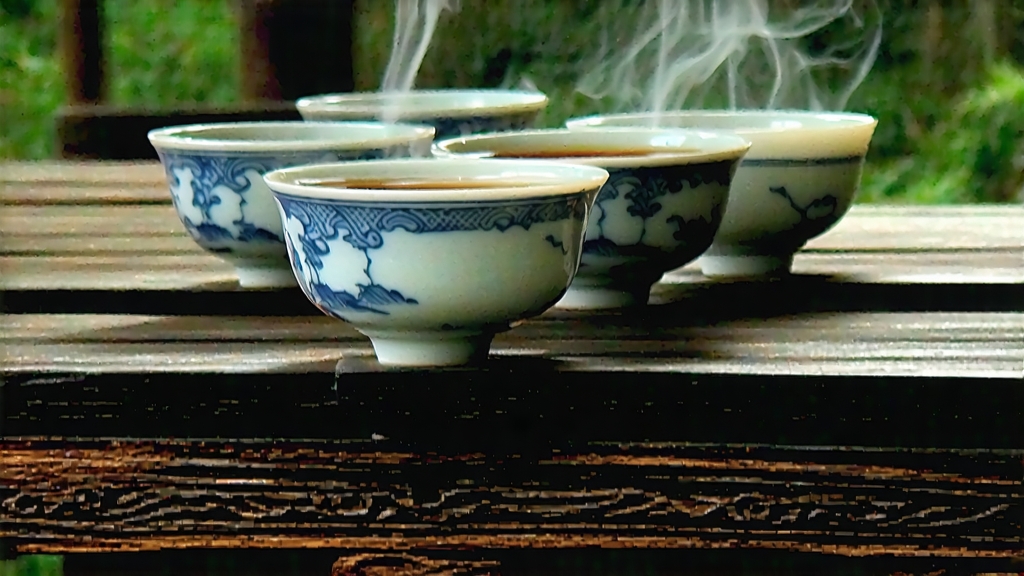
When Chinese tea lovers speak of “half-green, half-black” oolong, they are really speaking of a spectrum that stretches from the jade-green elegance of Tie Guan Yin to the ink-dark gravitas of Da Hong Pao. Among all oolongs, none carries more myth, more geological specificity, or more orchestral complexity than Da Hong Pao, literally “Big Red Robe,” the flagship of Wuyi yancha, or “rock tea.” To understand Da Hong Pao is to step into a micro-universe where Song-dynasty poetry, Ming-era court tribute, Qing-dynasty charcoal kilns, and 21st-century auction records all steep together in one cup.
-
Origins etched in cliff and legend
The Wuyi Mountains of northern Fujian are a 650-square-kilometer UNESCO double World Heritage site where 99 sheer cliffs push out of the Jiuqu (Nine-Bend) River like petrified waves. According to the most quoted legend, a Ming-dynasty scholar on his way to the capital fell gravely ill at the foot of Tianxin Rock. Monks from the nearby Tianxin Temple brewed leaves picked from six bushy trees growing out of a narrow fissure; the scholar recovered, passed the imperial exam, and returned in gratitude, draping his own red robe over the bushes. Whether factual or allegorical, the tale fixes three ideas that still define Da Hong Pao: it is medicine, it is imperial, and it is inseparable from the cliff itself. -
Mother trees, cuttings, and the genealogy of taste
Today the six original “mother trees” (mǔ shù) still cling to the same cleft, now protected by a state preserve and no longer harvested. Genetic fingerprinting shows they are not a single cultivar but a mixed population of distinct clones—Beidou, Queshe, Qi Dan, and others—each contributing different aromatic building blocks. Since the 1980s, agricultural scientists have taken cuttings (a technique called asexual propagation) and transplanted them to rocky farms throughout the 60-km Wuyi microclimate. The resulting teas are legally sold as “pure-strain Da Hong Pao,” while the majority of everyday production is a skillfully balanced blend of these clones plus other local Wuyi cultivars such as Rou Gui and Shui Xian, creating what is called “commodity Da Hong Pao.” Both styles can be superb; the former offers vertical depth, the latter horizontal complexity. -
Terroir: when rock becomes rhyme
French wine has “goût de terroir”; Wuyi tea has yan yun—literally “rock rhyme.” It is a sensory echo of the mineral-rich, weathered tuff and granite that force the roots to struggle, splitting into hair-fine filaments that absorb calcium, potassium, and trace metals. Morning mist rising from the river acts as a natural shade cloth, slowing photosynthesis and concentrating amino acids. The result is a liquor that tastes not merely floral or fruity but lithic—like licking a wet stone that has been warmed by the sun. Master cuppers evaluate yan yun by the lingering cool sensation at the back of the throat, a mentholated minerality that can last 20 minutes after swallowing. -
Craft: the nine-step choreography
Pluck: only the middle 3–4 leaves are taken in late April, when the leaf’s cellular walls have thickened enough to withstand the bruising ahead.
Wither: the leaves are spread on bamboo racks in a shaded corridor where mountain breeze reduces moisture to 65%.
Shaking: every hour for 6–8 hours the leaves are tossed in rattan drums, edge bruising that initiates oxidation at different rates across the leaf.
Oxidation: the leaf pile is left to rest in 25 °C rooms; oxidation is arrested at 30–40%, giving oolong its half-green heart.
Fixation: a 280 °C wok kill-green halts enzymes in 7 minutes, locking in the amber-to-come.
Rolling: the hot leaves are wrapped in cloth and rolled under mechanical pressure, rupturing cells for future infusions.
Roasting: the decisive Wuyi signature. Using local hardwood charcoal that has burned down to 600 °C embers, tea masters roast the leaf in bamboo sieves 3–8 times over 60–120 days. Each cycle lasts 2–4 hours, followed by 10–15 days of “resting” so